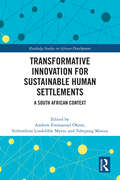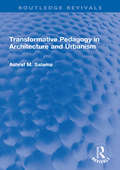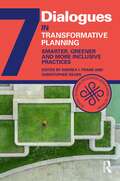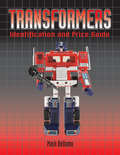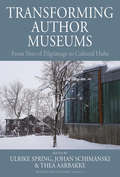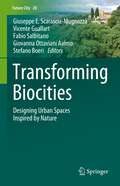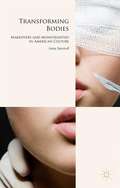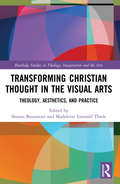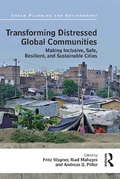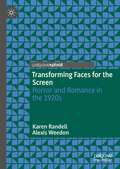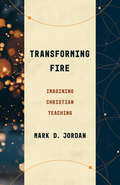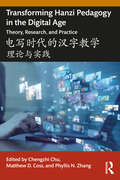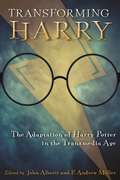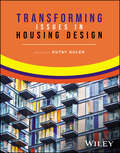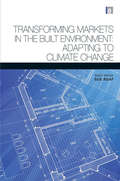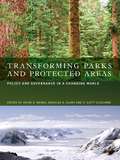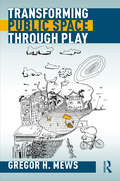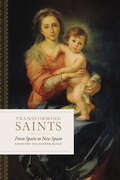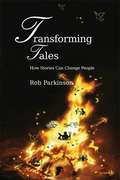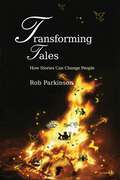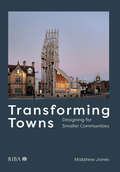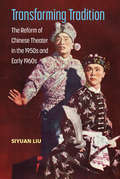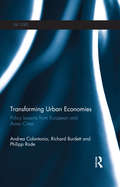- Table View
- List View
Transformative Innovation for Sustainable Human Settlements: A South African Context (Routledge Studies in African Development)
by Andrew Emmanuel Okem Sithembiso Lindelihle Myeni Tshepang MosieaThis book uses the transformative innovation policy (TIP) as a lens to show how innovative processes, practices and systems could address critical challenges and facilitate the delivery of sustainable human settlements in South Africa.The TIP approach shows that addressing societal problems is not a function of a technical solution within a government department but one that requires partnership with multiple stakeholders. The book argues that it is essential to understand and embrace innovation policy that is transformative and responds to the social and environmental needs at local, provincial and national levels. It demonstrates that innovation policy should focus on transforming the socio-technical systems that demand embracing notions such as experimental delivery and learning, directionality and inclusivity. Chapters explore the ability of the state to transform its organisational processes and capacity to improve and align its planning, implementation, monitoring and evaluation systems to high levels of efficiency and sustainability targets.Bringing together various theoretical and empirical perspectives on innovation in the context of sustainable human settlement, this book will be of interest to scholars and students in the fields of Housing, Human Settlements, Architecture, Public Policy, Development Studies, Civil Engineering, Political Science and Public Administration.
Transformative Pedagogy in Architecture and Urbanism (Routledge Revivals)
by Ashraf M. SalamaFirst published in 2009, Transformative Pedagogy in Architecture and Urbanism is a detailed round of pedagogical dialogue on architecture and urbanism that reset the stage for debating future visions of transformative pedagogy and its impact on design education. Structured in five chapters the book presents a wide range of innovative concepts and practical methodologies for teaching architectural and urban design. It traces the roots of architectural education and offers several contrasting ideas and strategies of design teaching practices. Transformative Pedagogy in Architecture and Urbanism will appeal to those with an interest in architectural and urban design, and architectural and design education.
Transformative Planning: Smarter, Greener and More Inclusive Practices
by Andrea I. FrankThe Dialogues in Urban and Regional Planning series offers a selection of some of the best scholarship in urban and regional planning from around the world with internationally recognized authors taking up urgent and salient issues from theory, to education for and practice of planning. This 7th volume features contributions on the theme of Transformative Planning: Smarter, Greener and More Inclusive Practices. It includes chapters from leading planning scholars and practitioners who critically examine how transformative planning practices seek to reduce inequalities, promote sustained, inclusive and sustainable economic growth, achieve gender equality, improve human health and well-being, foster resilience of urban communities and protect the environment and thereby change urban planning paradigms. Several case studies of emerging transformative planning interventions illustrate practical ways forward. Transformative Planning offers provocative insights into the global planning community’s struggle and contribution to tackle the major challenges to society in the 21st century. It will be of use for advanced undergraduate and graduate courses in the wide-ranging fields encompassed by urban studies, sustainability studies, and urban and regional planning. The Dialogues in Urban and Regional Planning (DURP) series is published in association with the Global Planning Education Association Network (GPEAN) and its member national and transnational planning schools associations.
Transformers: Identification and Price Guide
by Mark BellomoTransformers: Identification and Price Guide is the ultimate reference for all Generation One (G1) Transformers figures released from 1984 - 1990. Featuring more than 1,200 color photographs, this unparalleled guide presents every character in robot and alternate modes with accessories.Individual character biographies are presented from the original Tech Specs and also include function, personal motto, and ability scores. Notes on character history - as presented in the Sunbow cartoon series and Marvel comic books - are complemented by expert commentary on character attributes and popularity on today's secondary market. Current values for all figures in varying condition grades assist collectors in determining the value of their collections.Collectors, toy dealers, casual fans, and everyone who staged basement battles between the heroic Autobots and the evil Deceptions need an accurate identification and price guide to decipher the more than 300 G1 Transformers toys produced from 1984 - 1993. This is the definitive reference for your favorite "Robots in Disguise!"
Transforming Author Museums: From Sites of Pilgrimage to Cultural Hubs (Museums and Collections #13)
by Thea Aarbakke Ulrike Spring, Johan SchimanskiLiterary museums today must respond to new challenges; the traditional image of the author’s home museum as a sacred place of literary pilgrimage centered around a national hero has been questioned, and literary museums have begun to develop new strategies centered not only on biography, but also literary texts, imagined spaces, different readers, historical contexts, architectural concepts, and artistic interventions. As this volume shows, the changing of spaces asks how literary museums create new ways of interlinking real and literary spaces, texts, objects, readers, and tourists.
Transforming Author Museums: From Sites of Pilgrimage to Cultural Hubs (Museums and Collections #13)
by Thea Aarbakke Ulrike Spring, Johan SchimanskiLiterary museums today must respond to new challenges; the traditional image of the author’s home museum as a sacred place of literary pilgrimage centered around a national hero has been questioned, and literary museums have begun to develop new strategies centered not only on biography, but also literary texts, imagined spaces, different readers, historical contexts, architectural concepts, and artistic interventions. As this volume shows, the changing of spaces asks how literary museums create new ways of interlinking real and literary spaces, texts, objects, readers, and tourists.
Transforming Barcelona: The Renewal of a European Metropolis
by Tim MarshallThis unique book, written by local experts in the city, deals with the transformation of Barcelona during the last twenty years. Barcelona has been held up as a model of urban planning and economic regeneration amongst built environment professionals. The redesign of square parks and streets throughout the city in the 1980s first attracted attention and praise and then the 1992 Olympics hosted in the city raised international awareness. The city received many awards and accolades including a Gold Medal from the RIBA. The selection of writings is well illustrated throughout with maps, drawings and photographs and will be of interest to architects, planners and urban designers as well as those interested in the social and economic impacts of regeneration.
Transforming Biocities: Designing Urban Spaces Inspired by Nature (Future City #20)
by Giuseppe E. Scarascia-Mugnozza Vicente Guallart Fabio Salbitano Giovanna Ottaviani Aalmo Stefano BoeriThis edited volume centers around the concept of BioCities, which aim to unify nature and urban spaces in order to reverse the effects of global climate change and inequity. Following this principle, the authors propose multiple approaches for sustainable city growth. The discussed concepts are not only relevant for newly constructed cities, but offer transformative perspectives for existing settlements as well. Placing nature at the forefront of city planning is not an entirely new concept, so the authors build on established ideas like the garden city, green city, eco-city, or smart city. All chapters aim to highlight aspects to develop a city that is a resilient nature-based socio-ecological system. Many of these concepts were formed in an effort to copy the best traits of a forest ecosystem: a home for many different species that build complex communities. Much like many of our forests, urban areas are managed by humans for multifunctional purposes, using living and abiotic components. This viewpoint helps to understand the potential and limitations of sustainable growth. With these chapters, the authors want to inspire planners, ecologists, urban foresters and decision makers of the future.
Transforming Bodies
by Heike SteinhoffAt the turn of the twenty-first century, American media abound with images and narratives of bodily transformations. Transforming Bodies investigates how these representations have become key sites for the negotiation of power. Focusing on the representations of 'extreme' forms of somatic transformations, particularly cosmetic surgery, this book examines iconic popular cultural texts from diverse media and genres. The reality TV show The Swan, the TV drama series Nip/Tuck, Chuck Palahniuk's(post-)postmodern novels Invisible Monsters and Invisible Monsters Remix, and Scott Westerfeld's young adult fiction series Uglies are read as expressions of the heterogeneous biopolitical discourses that are articulated in the American mediascape. In contemporary American culture, representations of body transformations are often part of a makeover paradigm that presents bodies as 'beautiful,' 'individual' and 'improved' if they adhere to normative constructions of gender, sexuality, class, race/ethnicity, and able-bodiedness. However, Transforming Bodies demonstrates that a number of popular cultural texts take up narrative structures, representational strategies and ideological underpinnings of makeover culture in order to re-write them. These texts link makeovers to images, practices, and narratives of monstrosity and thereby challenge cultural norms. At the crossroads of American, cultural, literary, media, gender, queer, disability and governmentality studies, the book presentsa timely intervention into critical debates on body transformations and contemporary makeover culture.
Transforming Christian Thought in the Visual Arts: Theology, Aesthetics, and Practice (Routledge Studies in Theology, Imagination and the Arts)
by Sheona Beaumont and Madeleine Emerald ThieleThis volume explores how the visual arts are presenting and responding to Christian theology and demonstrates how modern and contemporary artists and artworks have actively engaged in conversation with Christianity. Modern intellectual enquiry has often been reluctant to engage theology as an enriching or useful form of visual analysis, but critics are increasingly revisiting religious narratives and Christian thought in pursuit of understanding our present-day visual culture. In this book an international group of contributors demonstrate how theology is often implicit within artworks and how, regardless of a viewer’s personal faith, it can become implicit in a viewer’s visual encounter. Their observations include deliberate juxtaposition of Christian symbols, imaginative play with theologies, the validation of non-confessional or secular public engagement, and inversions of biblical interpretation. Case studies such as an interactive Easter, glow-sticks as sacrament, and visualisation of the Bible’s polyphonic voices enrich this discussion. Together, they call for a greater interpretative generosity and more nuance around theology’s cultural contexts in the modern era. By engaging with theology, culture, and the visual art, this collection offers a fresh lens through which to see the interaction of religion and art. As such, it will be of great use to those working in Religion and the Arts, Visual Art, Material Religion, Theology, Aesthetics, and Cultural Studies.
Transforming Distressed Global Communities: Making Inclusive, Safe, Resilient, and Sustainable Cities (Urban Planning and Environment)
by Fritz Wagner Riad Mahayni Andreas PillerMany of our global cities are distressed and facing a host of issues: economic collapse in the face of rising expectations, social disintegration and civil unrest, and ecological degradation and the threats associated with climate change, including more frequent and more severe natural disasters. Our long-held assumptions about man and nature and how they interact are defunct. We realize now that we can no longer continue to build without addressing the long-term impacts of our actions and their spillovers. Energy and natural resources are finite. The way we configure economies has come into question. In the developed world, especially in the United States, infrastructure and the notions that underpin it are outdated. Meanwhile, the developing world is experiencing major, rapid transformations in lifestyles and economies that are affecting billions of people and requiring a whole new way of planning human settlements. Cities are the key to our future; they represent the most effective vehicle for positive advancements in the human condition and environmental change. This volume argues for the need to redesign and re-plan our cities in holistic ways that reflect our new understanding and relate to their diversity and multi-dimensionality. Presenting a range of case studies from around the world, this volume examines how these distressed cities are dealing with these issues in planning for their future. Alongside these empirical chapters are philosophical essays that consider the future of distressed cities. Bringing together a team of leading scholars, United Nations agencies, non-governmental organizations, private consulting firms, international organizations and foundations, and policy officials, this volume provides a unique and comprehensive overview on how to transform distressed communities into more livable places.
Transforming Faces for the Screen: Horror and Romance in the 1920s
by Karen Randell Alexis WeedonThis book brings together research from medical and film archives to illustrate the cultural impact of film and literature in its relationship to the discourse of plastic surgery in the 1920s. This different take on reading the body after the First World War enables students of multiple disciplines, and readers interested in both Hollywood and post-war culture, to understand some of the complexities of medical interventions gained after the First World War and the way in which they filtered into the world of Hollywood film making. It also allows readers who may not be familiar with these two 1920s stars to access the films of Lon Chaney and the books and films of Elinor Glyn and gain new insights into 1920s visual culture. For ease of readership, the book is organised so that each of the main chapters focuses on a particular film (either Lon Chaney or Elinor Glyn). This is particularly useful for use in the classroom or for online education. Readers can refer to the film directly, aided by illustrations of frames from the films. This book tells the story of how two stars of Hollywood film transformed their character’s faces on screen through a close reading of three films in the 1920s. It reveals how they applied their embodied knowledge of surgery and surgical procedures to broaden their audience’s emotional and intellectual understanding of the treatment of deformity and disability.
Transforming Fire: Imagining Christian Teaching (Theological Education between the Times)
by Mark D. Jordan&“We don&’t need books about teaching so much as books that teach.&” Considering Jesus himself taught in a variety of ways—parable, discussion, miracle performance, ritual observance—it seems that there can be no single, definitive, Christian method of teaching. How then should Christian teaching happen, especially in this time of significant change to theological education as an institution? Mark Jordan addresses this question by first allowing various depictions and instances of Christian teaching from literature to speak for themselves before meditating on what these illustrative examples might mean for Christian pedagogy. Each textual scene he shares is juxtaposed with a contrasting scene to capture the pluralistic possibilities in the art of teaching a faith that is so often rooted in paradox. He exemplifies forms of teaching that operate beyond the boundaries of scholarly books and discursive lectures to disrupt the normative Western academic approach of treating theology as a body of knowledge to be transmitted merely through language. Transforming Fire consults writers ranging from Gregory of Nyssa to C. S. Lewis, and from John Bunyan to Octavia Butler, cutting across historical distance and boundaries of identity. Rather than offering solutions or systems, Jordan seeks in these texts new shelters for theological education where powerful teaching can happen and—even as traditional institutions shrink or vanish—the hearts of students can catch fire once again.
Transforming Hanzi Pedagogy in the Digital Age: 电写时代的汉字教学: 理论与实践
by Chengzhi Chu Matthew D. Coss Phyllis N. ZhangTransforming Hanzi Pedagogy in the Digital Age 电写时代的汉字教学 brings together expert researchers and practitioners to offer a coherent theoretical, empirical, pedagogical, and experiential justification for a shift in pedagogical focus from handwriting to e-writing in L2 Chinese pedagogy.This volume argues for a pedagogy based on the 21st century communicative needs of L2 Chinese users, grounded in empirical research as well as practical and lived experiences. The authors propose an “e-writing as primary” (电写为主,手写为辅) framework for L2 Chinese instruction in the 21st century, a transformational proposal which will fundamentally shift the pedagogical focus of L2 Chinese instruction globally towards more learner-centered, research-informed practice. This volume includes three theoretical foundation chapters, four empirical studies, three descriptions of program-level implementation, and ten expert L2 Chinese user vignettes, which, taken together, offer a thorough introduction to e-writing for the future of L2 Chinese teaching and learning.This book will be informative for Chinese language instructors, researchers, program directors, materials developers, and advanced graduate students in both CFL and CSL contexts worldwide.
Transforming Harry: The Adaptation of Harry Potter in the Transmedia Age (Contemporary Approaches to Film and Media Series)
by Kelly Turner John Alberti Vera Cuntz-Leng P. Andrew Miller Andrew Howe Cassandra Bausman Maria Dicieanu Katharine McCain Michelle Markey Butler Liza Potts Emily DallaireTransforming Harry: The Adaptation of Harry Potter in the Transmedia Ageis an edited volume of eight essays that look at how the cinematic versions of the seven Harry Potter novels represent an unprecedented cultural event in the history of cinematic adaptation. The movie version of the first Harry Potter book, Harry Potter and the Sorcerer’s Stone, premiered in 2001, in between publication of the fourth and fifth books of this global literary phenomenon. As a result, the production and reception of both novel and movie series became intertwined with one another, creating a fanbase who accessed the series first through the books, first through the movies, and in various other combinations. John Alberti and P. Andrew Miller have gathered scholars to explore and examine the cultural, political, aesthetic, and pedagogical dimensions of this pop culture phenomenon and how it has changed the reception of both the films and books. Divided into two sections, the volume addresses both the fidelity of adaptation and the transmedia adaptations that have evolved around the creation of the books and movies. In her essay, Vera Cuntz-Leng draws on feminist film theory to explore the gaze politics and male objectification operating in the Harry Potter movies. Cassandra Bausman contends that screenwriter Steve Klove’s revision of the end of the film version of Deathly Hallows, Part II offers a more politically and ethically satisfying conclusion to the Harry Potter saga than the ending of the Rowling novel. Michelle Markey Butler’s "Harry Potter and the Surprising Venue of Literary Critiques" argues that the fan-generated memes work as a kind of popular literary analysis in three particular areas: the roles of female characters, the comparative analysis of books and films, and the comparative analysis of the Harry Potter series with other works of fantasy. While the primary focus of the collection is an academic audience, it will appeal to a broad range of readers. Within the academic community, Transforming Harry will be of interest to scholars and teachers in a number of disciplines, including film and media studies and English. Beyond the classroom, the Harry Potter series clearly enjoys a large and devoted global fan community, and this collection will be of interest to serious fans.
Transforming Issues in Housing Design
by Kutay GulerTRANSFORMING ISSUES IN HOUSING DESIGN A practical and complete resource for students, researchers, and practitioners of housing design Transforming Issues in Housing Design delivers a comprehensive vision for the design, philosophy, psychology, efficiency, and constitution of housing. This collection of articles explores many of the most pressing and relevant issues related to the ongoing transformation of housing design. Twenty-two contributed chapters discuss the past and current state of housing design, how it evolved to become what it is today, and, finally, how it may unfold in the future. A team of global experts presents the most up-to-date research and a diverse and illuminating collection of examples to highlight housing design around the world. Readers will also find: A thorough introduction to modern housing design and how it relieves and contributes to various social and economic problems Insightful explorations of the built environment, interior architecture, urban design, sustainable living, space planning, and more Practical discussions of a theoretical framework to make sense of housing design concepts Complete treatments of concepts, research, and built projects from a diverse range of communities and cultures Perfect for architects and students of urban studies, interior design, and architecture, Transforming Issues in Housing Design will also benefit those who design, research, and teach housing.
Transforming Markets in the Built Environment: Adapting to Climate Change (Architectural Science Review Series)
by Susan RoafThere is an urgent need to build human capacity to make the often vulnerable and exposed buildings and communities we live and work in more resilient to the changing social, economic and physical environments around us. Extensive research has been done over the last decades on both mitigation and adaptation to climate change in the built environment, but the outputs of much of this research have failed to result in the wider uptake of effective greenhouse gas emission reduction solutions. This volume introduces credible 'fresh thinking' on how this may be done. For the first time an emerging generation of research is brought together that is directly concerned with understanding, influencing and leading the transformation of markets and thinking in the built environment. Chapters cover: defining values setting targets consumer motivation selling existing ideas better developing new design principles, paradigms and programmes optimizing solutions to ensure that when change does happen, it does so in the right direction. Papers are contributed by leading experts in fields ranging from philosophy, the social, political and physical sciences, engineering, architecture, mathematics and complexity science. The resulting volume will be essential reading for all those involved with changing the mindsets of a generation on the need to, and ways to, build resilience to rapid change and transforming markets in the built environment.
Transforming Parks and Protected Areas: Policy and Governance in a Changing World
by Kevin S. Hanna Douglas A. Clark D. Scott Slocombe**This title was originally published in 2007. The version published in 2012 is a PB reprint of the original HB** The protection of natural resources and biodiversity through protected areas is increasingly based on ecological principles. Simultaneously the concept of ecosystem-based management has become broadly accepted and implemented over the last two decades. However, this period has also seen unprecedented rapid global social and ecological change, which has weakened many protection efforts. These changes have created an awareness of opportunities for innovative approaches to managing protected areas and of the need to integrate social and economic concerns with ecological elements in protected areas and parks management. A rare collection of articles that fuses academic theory, critique of practice and practical knowledge, Transforming Parks and Protected Areas analyzes and critiques these theories, practices, and philosophies, looking in-detail at the emerging issues in the design and operation of parks and protected areas. Addressing critical dynamics and current practices in parks and protected areas management, the excellent volume goes well beyond simple managerial solutions and descriptions of standard practice. With contributions from leading academics and practitioners, this book will be of value to all those working within ecology, natural resources, conservation and parks management as well as students and academics across the environmental sciences and land use management.
Transforming Public Space through Play
by Gregor H. MewsThis book provides an empirical analysis of the concept of play as a form of spatial practice in urban public spaces. The introduced City–Play–Framework (CPF) is a practical urban analysis tool that allows urban designers, landscape architects and researchers to develop a shared awareness when opening up this window of possibility for adventure. Two case studies substantiate and illustrate the development process and testing of the framework in Canberra, Australia, and Potsdam, Germany. The appropriation of public spaces that transcend boundaries can facilitate an intrinsic connection between people and their immediate environment, towards a more joyful ontological state of human existence in which imagination, co-creation and a sense of agency are key elements of the design approach. The framework presents an alternative understanding of public spaces and public life, reflecting on theory and its implications for practice in a post-pandemic world in dense urban centres. A bridge between theory and practice, this book explores possibilities on what future design ought to be when openness and ambiguity are consciously integrated parts of practice and process. The book presents a valuable discussion on public space and play for academic audiences across a wide range of disciplines such as landscape architecture, urban design, planning, architecture and urban sociology, which is informative for future practice.
Transforming Saints: From Spain to New Spain
by Charlene Villaseñor BlackTransforming Saints explores the transformation and function of the images of holy women within wider religious, social, and political contexts of Old Spain and New Spain from the Spanish conquest to Mexican independence. The chapters here examine the rise of the cults of the lactating Madonna, St. Anne, St. Librada, St. Mary Magdalene, and the Suffering Virgin. Concerned with holy figures presented as feminine archetypes—images that came under Inquisition scrutiny—as well as with cults suspected of concealing Indigenous influences, Charlene Villaseñor Black argues that these images would come to reflect the empowerment and agency of women in viceregal Mexico. Her close analysis of the imagery additionally demonstrates artists' innovative responses to Inquisition censorship and the new artistic demands occasioned by conversion. The concerns that motivated the twenty-first century protests against Chicana artists Yolanda López in 2001 and Alma López in 2003 have a long history in the Hispanic world, in the form of anxieties about the humanization of sacred female bodies and fears of Indigenous influences infiltrating Catholicism. In this context Black also examines a number of important artists in depth, including El Greco, Murillo, Jusepe de Ribera, Pedro de Mena, Baltasar de Echave Ibía, Juan Correa, Cristóbal de Villalpando, and Miguel Cabrera.
Transforming Tales: How Stories Can Change People
by Rob ParkinsonWritten by an experienced professional storyteller, this book contains about 90 short stories, from traditional fables and myths to modern yarns and jokes, allowing readers to understand the hidden patterns storytellers use to captivate attention and reveal truths. The author delves into the therapeutic value of stories and how they can instigate real change in people's lives, and shows how to create original stories and short metaphors. The book's readership includes those working to facilitate psychological and personal change, including therapists, social workers, coaches, teachers, managers, and presenters, as well as storytellers.
Transforming Tales: How Stories Can Change People
by Rob Parkinson'A very interesting and unusual book...The central theme of stories for change is challenging and exciting and it offers a good deal of wisdom about working with stories and insights into the stories themselves' â?? Mary Medlicott, storyteller, author of Shemi's Tall Tales and Cooking up a Story 'An illuminating account of the stories behind, within, above and below metaphors. The author's style is wonderfully engaging and flows beautifully from start to finish... This book will inspire anyone who works in therapeutic, creative, educational or business settings as well as being a joyful read to those who are fascinated by stories, fables and folklore. - Jaycee la Bouche, hypnotherapist, NLP confidence coach and children's relaxation teacher, Relax Kids ''This is a source of fabulous ideas and insights on the art of storytelling I will dip into again and again. Thought provoking explanations and rich examples are underpinned with biological information all of which flow easily from Rob's huge experience and skill as a storyteller. It seems as if stories really are wound into our DNA.' â?? Andy Vass, psychotherapist, coach and author of Teaching with Influence and Coaching and Mentoring for Leaders The power of story in our lives is far from adequately understood in contemporary culture. Equally the therapeutic power of storytelling, how it can quite literally entrance and even heal, has been ignored until recently. Transforming Tales reveals the true of impact of stories on our lives and how stories can create feelings of hope, take away psychological distress and even stimulate the immune system. Written by an experienced professional storyteller, this book contains over 90 short stories, from traditional fables to fascinating modern yarns, and allows readers to understand the hidden patterns storytellers use to captivate attention and learn how truths are often encapsulated in myths, jokes and fairy stories.The author focuses on the therapeutic value of stories and how they can instigate real change in people's lives. The book also reveals everything you need to know to create vibrant, memorable, original stories and short metaphors for yourself. This extraordinary journey into imagination and understanding will be an illuminating read for those professionally concerned with psychological and personal change and anyone who wants to learn more about the power and significance of stories.
Transforming Towns: Designing for Smaller Communities
by Matthew JonesTowns have undergone dramatic and rapid change over the last century. Declining historic cores are surrounded by sprawling low-density housing, industrial and retail estates. The character and sense of place at the heart of rural towns and villages is under threat. By drawing people away from town centres, these developments erode the sense of community and public life. This book demonstrates how contemporary architecture, community engagement and thoughtful urban design can contribute to the creation of thriving small communities. It addresses a lack of inspiration and ideas for architects and designers working in small communities and promotes a character-based approach to designing and planning 21st century towns.
Transforming Tradition: The Reform of Chinese Theater in the 1950s and Early 1960s
by Siyuan LiuShortly after the establishment of the People’s Republic of China in 1949, the PRC launched a reform campaign that targeted traditional song and dance theater encompassing more than a hundred genres, collectively known as xiqu. Reformers censored or revised xiqu plays and techniques; reorganized star-based private troupes; reassigned the power to create plays from star actors to the newly created functions of playwright, director, and composer; and eliminated market-oriented functionaries such as agents. While the repertoire censorship ended in the 1980s, major reform elements have remained: many traditional scripts (or parts of them) are no longer in performance; actors whose physical memory of repertoire and acting techniques had been the center of play creation, have been superseded by directors, playwrights, and composers. The net result is significantly diminished repertoires and performance techniques, and the absence of star actors capable of creating their own performance styles through new signature plays that had traditionally been one of the hallmarks of a performance school. Transforming Tradition offers a systematic study of the effects of the comprehensive reform of traditional theater conducted in the 1950s and ’60s, and is based on a decade’s worth of exhaustive research of official archival documents, wide-ranging interviews, and contemporaneous publications, most of which have never previously been referenced in scholarly research.
Transforming Urban Economies: Policy Lessons from European and Asian Cities (LSE Cities)
by Andrea Colantonio Philipp Rode Richard BurdettCities house the majority of the world’s population and are the dynamic centres of 21st century life, at the heart of economic, social and environmental change. They are still beset by difficult problems but often demonstrate resilience in the face of regional and national economic decline. Faced by the combined threats of globalisation and world recession, cities and their metropolitan regions have had to fight hard to maintain their global competitiveness and protect the quality of life of urban residents Transforming Urban Economies: Policy Lessons from European and Asian Cities, the first in an ongoing series of research volumes by LSE Cities, provides insights in how cities can respond positively to these challenges. The fine-grained and authoritative analysis of how Barcelona, Turin, Munich and Seoul have been transformed in the last 20 years examines comparative patterns of decline, adaptation and recovery of cities that have successfully managed to transform their economies in the face of economic hardship. This in-depth and practical analysis is aimed at urban leaders, designers, planners, policymakers and scholars who want to understand the dynamics of economic resilience while cities are still suffering from the aftershocks of the 2008 recession. The book highlights the importance of aligned and multi-level governance, the need for strategic public investments and the role of the private sector, universities and foundations in leading and guiding complex processes of urban recovery in an increasingly uncertain age.
